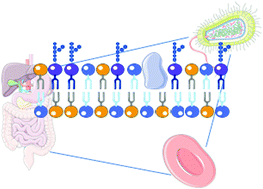Investigating lipid headgroup composition within epithelial membranes: a systematic review†
Abstract
Membrane lipid composition is often quoted within the literature, but with very little insight into how or why these compositions vary when compared to other biological membranes. One prominent area that lacks understanding in terms of rationale for lipid variability is the human gastro-intestinal tract (GIT). We have carried out a comprehensive systematic literature search to ascertain the key lipid components of epithelial membranes, with a particular focus on addressing the human GIT and to use compositional data to understand structural aspects of biological membranes. Both bacterial outer membranes and the human erythrocyte membrane were used as a comparison for the mammalian [epithelial] membranes and to understand variations in lipid presence. We show that phosphatidylcholine (PC) lipid types tend to dominate (33%) with phosphatidylethanolamines (PE) and cholesterol having very similar abundances (25 and 23% respectively). This systematic review presents a detailed insight into lipid headgroup composition and roles in various membrane types, with a summary of the distinction between the major lipid bilayer forming lipids and how peripheral lipids regulate charge and fluidity. The variety of lipids present in biological membranes is discussed and rationalised in terms function as well as cellular position.



 Please wait while we load your content...
Please wait while we load your content...